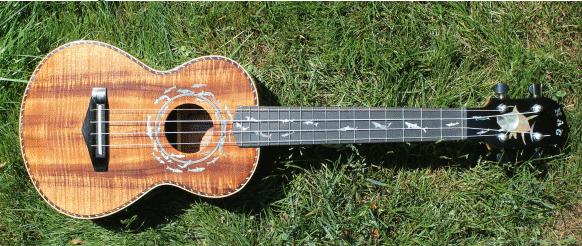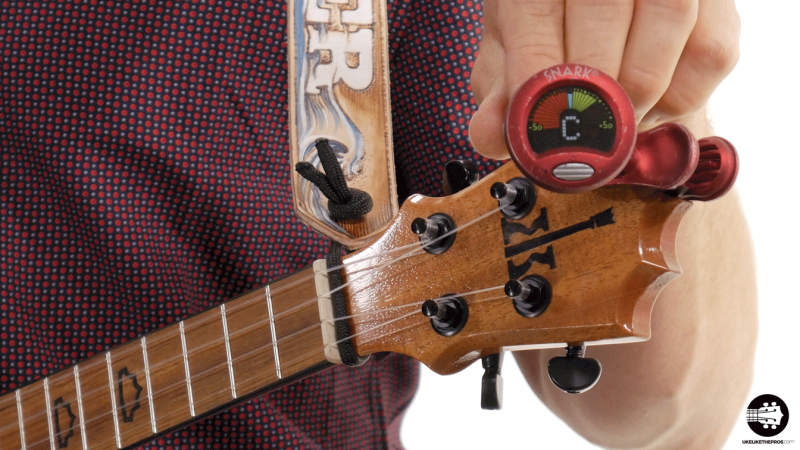This is a guest post by Jonathan Dale, of Jupiter Ukulele, who builds his own ukuleles from local wood found in Eastern Pennsylvania.
Wood. Most stringed musical instruments, including ukuleles, are made out of wood. (There are the plastic ukuleles, and the carbon-fiber ones, but we’ll leave those aside.) Wood, being a wonderful product of nature comes in an almost infinite variety with an almost infinite variety of characteristics. Couple this variability in the basic material with all of the design and construction choices that one can make when building a musical instrument and the possibilities are endless.
Wood and its Purpose
Wood in an instrument serves two purposes, with two different sets of characteristics. First and foremost is how the wood reacts to, changes, and hopeful enhances the energy of a plucked string so that the energy in that plucked string is converted into sound energy. This is the source of the endless debate about which type of wood ‘sounds better’.

Then there is the secondary purpose of being pleasing to the eye. How a piece of wood looks may not be central to making music, but it is important to the happiness of the player of the instrument. If every time one opens the case one gets to take out a beautiful sculptural object, (which a ukulele can certainly be) a player will be that much more inspired to play and practice. Does curly koa sound better than straight grained koa, I don’t think so but that curly stuff sure looks good!
Top, Back and Side Wood
When building a stringed instrument like a ukulele one generally differentiates between the top wood, which responds directly to the vibration of the strings, and the wood used on the back and sides which (depending on your thinking) may amplify the top vibrations, or may isolate the energy of the top vibrations to just the top. For this discussion we will focus on the back and side wood, since that is where most of the ‘looks’ come from.
There is lots of debate, but from reading I have done, and my own personal experience, the choice of back and side wood may have a 15% effect on the overall sound. From the guitar world there is much reverence paid to things like Brazilian rosewood as being the cream of the wood crop. This in spite of other experiments that used alternate woods, and in a blind test listeners could not pick out Brazilian. (Still, it looks lovely.) Then there is the problem of overharvesting of the tropical rosewoods, illegal logging in the rain-forest, CITES listing which effects import/export or taking an instrument across international borders (like to Canada), etc. (However, the vast majority of the tropical harvesting does not go into instrument production.)
Local Wood
I live in Eastern Pennsylvania, in the Appalachian region. The Appalachian region is hardwood central to the US with all sorts of species, growing in all sorts of environments. I decided that I did not want to build instruments with wood that came from some tropical forest, who knows where and who knows how. Certainly there must be great instrument woods available locally. (Also, I’ll admit it, I’m frugal and local wood can be had for much less up-front monetary expenditure.) These days a lot of the back and side woods I use started with me and a chainsaw. I have not directly taken down any trees, but keep my eyes out and take advantage of trees that have been taken down for other reasons and some wood comes from a local sawmill, sawing locally harvested trees. Some examples of what I am using:
Sycamore Wood
When putting in a new bridge near my house, they took down a big old sycamore tree (Platanus occidentalis). I went and cut a number of big billets, that I later re-sawed into ukulele wood. Sycamore, being related to the maples, make a great sounding instrument, and when sawn just right has a spectacular grain pattern. One of the advantages of harvesting my own sycamore is that I can cut it ‘just so’ to reveal the grain pattern. Get off even a few degrees on the angle that the wood is cut and the pattern disappears. I have a stack of wood that you just can not buy.

I have cut some black walnut (Juglans nigra) from left-overs of a logging operation and have bought a chunk from the local sawmill. A black walnut body and redwood top (see my blog for more on the redwood, recycled from of water-tank planks) makes a superb sounding instrument.

South Florida Wood – The Casuarina
My latest ‘discovery’ is a wood that was planted all over South Florida, and it is now considered an invasive species. In Florida, it is known as “Australian Pine” though it is not a pine. I know it as Casuarina (Casuarina equisetifolia). It is harder and heavier than the rosewood, (comparable to ebony), sinks in water even when dry, rings when you tap it and it looks great to boot. I cut some from trees taken down as part of restoring a natural area (cutting out the invasive trees) and that were blown down in a hurricane. Casuarina takes a wonderful polish, makes great body and side wood as well as fingerboards. One is using wood from an invasive species so there is no cutting of rainforest trees to get a hard heavy lovely wood, though you have to do it yourself, there is no commercial harvesting of
Casuarina.

Other Local Goodies
Then there are many other local goodies; dogwood & dogwood burls, black locust, curly maple (both red maple and sugar maple), curly ash, old spruce trees, etc. As a small builder I have the opportunity to individually source and cut particular pieces of wood, to maximize the potential of each piece of wood both acoustically and aesthetically. A production shop or factory does not have this ability, but rather has to rely on consistently available and more uniform materials that can be processed with a minimum of labor. I have the luxury of being surrounded by wood, and I keep my chainsaw sharpened because who knows when one will be driving past that next great thing!



